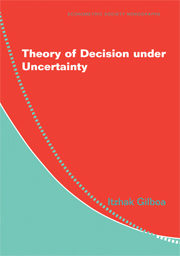Book contents
- Frontmatter
- Contents
- Preface
- I Intuitive Definitions
- II Behavioral Definitions
- 6 A Case Study
- 7 The Role of Theories
- 8 Von Neumann–Morgenstern's Theorem
- 9 De Finetti's Theorem
- 10 Savage's Theorem
- 11 The Definition of States
- 12 A Critique of Savage
- 13 Objectivity and Rationality
- 14 Anscombe–Aumann's Theorem
- III Alternative Behavioral Theories
- IV Cognitive Origins
- References
- Index
- Titles in the series
8 - Von Neumann–Morgenstern's Theorem
Published online by Cambridge University Press: 05 January 2013
- Frontmatter
- Contents
- Preface
- I Intuitive Definitions
- II Behavioral Definitions
- 6 A Case Study
- 7 The Role of Theories
- 8 Von Neumann–Morgenstern's Theorem
- 9 De Finetti's Theorem
- 10 Savage's Theorem
- 11 The Definition of States
- 12 A Critique of Savage
- 13 Objectivity and Rationality
- 14 Anscombe–Aumann's Theorem
- III Alternative Behavioral Theories
- IV Cognitive Origins
- References
- Index
- Titles in the series
Summary
BACKGROUND
The idea of maximization of expected utility first appeared explicitly in Daniel Bernoulli's St. Petersburg paradox (Bernoulli, 1738), which goes as follows: you are faced with a sequence of tosses of a fair coin. Every toss has a probability of 50% to come up on head and on tail, and the game will end the first time the coin comes up head. If this happens on the nth trial, you get 2n dollars. The “paradox” is that most people are willing to pay only a finite (and rather small) amount of money to play this game, despite the fact that the expected value is infinite. As a resolution, Bernoulli suggested that people maximize the expectation of a utility function, rather than of monetary value. If the function is logarithmic, the expected utility is finite and the paradox is resolved.
As an aside, it may be worthwhile to wonder what is meant by a “paradox.” For many people, there is nothing paradoxical about the fact that people do not necessarily maximize expected value. It is possible that an example showing this was deemed “paradoxical” to Bernoulli's audience in 1738 but not to graduate students in economics in the twenty-first century. Indeed, the notion of a “paradox” is a subjective and quantitative matter.
- Type
- Chapter
- Information
- Theory of Decision under Uncertainty , pp. 78 - 88Publisher: Cambridge University PressPrint publication year: 2009



